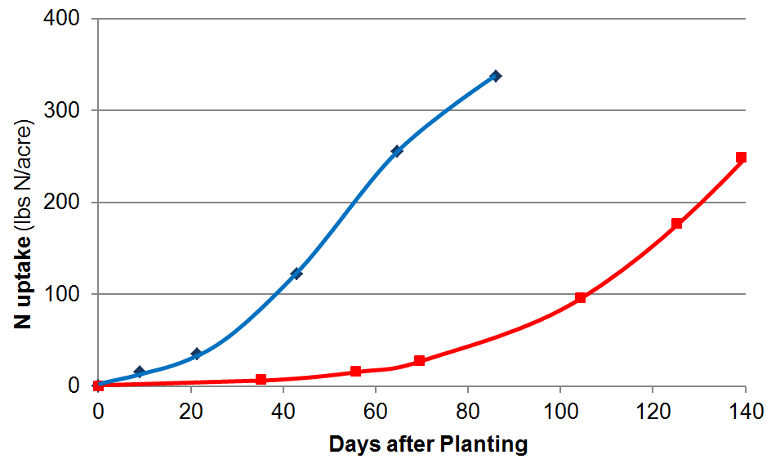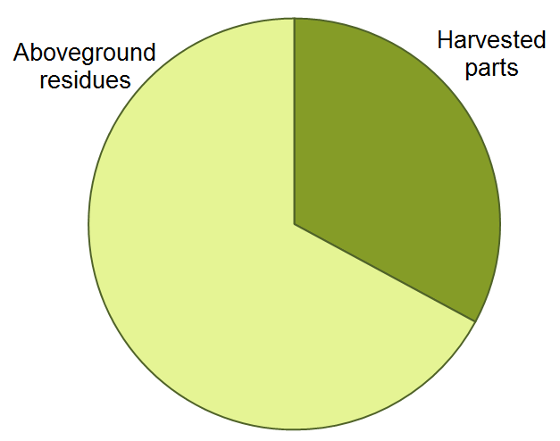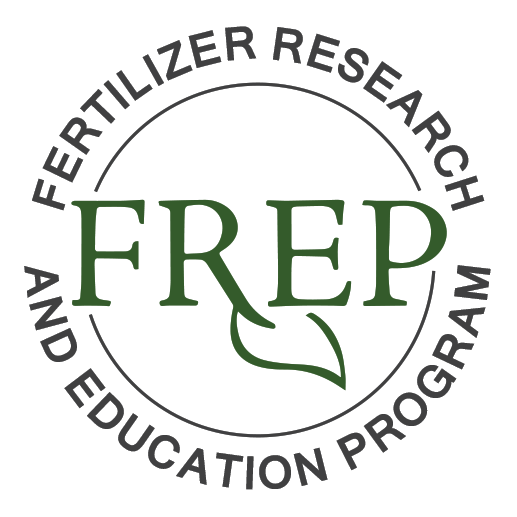Broccoli Nitrogen Uptake and Partitioning
Seasonal N Uptake

The N uptake curve is based on a study on grower fields in Monterey County where direct-seeded summer (blue line) and winter (red line) broccoli were fertilized with 182 lbs N/acre and 272 lbs N/acre, respectively [7]. Broccoli N uptake was determined by harvesting the aboveground biomass. Other research has shown that the N application rate has a considerable effect on plant N accumulation [2].
Nitrogen Partitioning

In winter-grown broccoli, roughly 40% of the total aboveground N is removed with the harvested parts (inflorescence and top of the stem). For summer crops, which have a larger biomass, only about 30% is removed [7].
Nitrogen Removed at Harvest
Nitrogen removed with harvested portions of broccoli crops. The overall average is weighted for the number of observations in each trial. More information can be found here href="#References">[3].
| Location | Years | Removal (lbs N/ton fresh weight) | Source | |
|---|---|---|---|---|
| Mean | Range | |||
| Salinas, CA | 2012-13 | 9.0 | 7.73 - 11.64 | [6] |
| Arizona | 2000 | 11.3 | 11.01 - 11.91 | [8] |
| Canada | 2001-02 | 12.5 | 11.58 - 14.5 | [1, 2] |
| Canada | 1990-91 | 12.4 | 7.48 - 19.01 | [9] |
| Spain | 1996 | 10.5 | [5] | |
| Various | 11.6 | [4] | ||
| Weighted Average | 11.2 | 7.48 - 19.01 | ||
Links
References
- Bakker, C.J., Swanton, C.J., McKeown, A.W., 2009a. Broccoli growth in response to increasing rates of pre-plant nitrogen. I Yield and quality. Canadian Journal of Plant Science 89, 527-537.
- Bakker, C.J., Swanton, C.J., McKeown, A.W., 2009b. Broccoli growth in response to increasing rates of pre-plant nitrogen. II. Dry matter and nitrogen accumulation. Canadian Journal of Plant Science 89, 539-548.
- Geisseler, D., 2016. Nitrogen concentrations in harvested plant parts - A literature overview. Report to the Kings River Watershed Coalition.
- Howard, F.D., MacGillivray, J.H., Yamaguchi, M., 1962. Nutrient composition of fresh California-grown vegetables. California Agricultural Experiment Station, Bulletin No. 788, California Department of Agriculture.
- Rincon L., Saez J., Perez Crespo J.A., Gomez Lopez M.D., Pellicer C., 1999. Crecimiento y absorcion de nutrientes del brocoli. Investigación Agraria. Producción y Protección Vegetales 14, 225-236.
- Smith, R., Cahn, M., Hartz, T.K., 2013. Survey of nitrogen uptake and applied irrigation water in broccoli, cauliflower and cabbage production in the Salinas Valley. CDFA-FREP Conference Proceedings 2013, 117-119. Complemented withunpublished data.
- Smith, R., Cahn, M., Hartz, T.K., 2015. Survey of nitrogen uptake and applied irrigation water in broccoli, cauliflower and cabbage production in the Salinas Valley. FREP Final Report.
- Thompson, T.L. White, S.A., Walworth, J., Sower, G.J., 2003. Fertigation frequency of subsurface drip-irrigated broccoli. Soil Science Society of America Journal 67, 910–918.
- Zebarth, B.J., Bowen, P.A., Toivonen, P.M.A., 1995. Influence of nitrogen fertilization on broccoli yield, nitrogen accumulation and apparent fertilizer-nitrogen recovery. Canadian Journal of Plant Science 75, 717-725.

